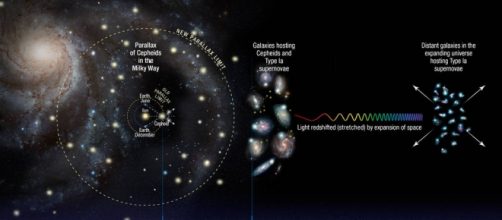With the aid of the Hubble Space Telescope, astronomers discovered that the universe is expanding at rates that range from five to 10 percent faster than it was thought. A team performed new measuring techniques, in three steps, to distant galaxies. It´s believed that these findings might allow getting a better understanding at the part of the cosmos that cannot be seen, such as dark matter, dark energy, and dark radiation.
Measuring technique
Astronomers use Cepheid variables, a type of star whose luminosity and pulsation period indicates distance, within the Milky Way.
Knowing their true and apparent brightness, they are able to determine distance using the parallax technique. Cepheids are used as benchmarks against which distance to other galaxies is calculated. The rate at which Cepheids pulsate reveals their true luminosity; slower pulses indicate more luminosity. True brightness is then compared against their apparent brightness, as observed from earth, to find their exact distance.
Now, the measurements move out of the Milky Way to other galaxies. There, scientists search for Cepheids and type 1a supernovae, another yardstick for determining distances in the universe. Type 1a supernovae produce consistent luminosity. In this galaxy, Cepheids are utilized to determine the true luminosity of supernovae and these combined analyses provide the distance of the galaxy.
Now, astronomers search for supernovae in more distant galaxies. Here, astronomers only use type 1a supernovae, which contrary to Cepheids, their luminosity is more distinguishable from greater distances. Scientists compare the true and apparent luminosity of supernovae to determine the distance where the expansion of the universe is occurring. The measurements are contrasted at how the light from the supernovae is redshifted by the enlargement of space. These values are used to calculate the rate at which the universe is expanding with time.
Explanation for the expansion of the universe
Scientists believe that dark energy could be pushing galaxies away from each other with greater force. Dark radiation, which could have travelled at the speed of light since the big bang, could be putting additional energy into the expansion of the cosmos, and dark matter -- which does not emit light or energy -- could be acting strangely in the empty space of the universe.
The new upgraded constant value is calculated at 73 km/s/MPEC (1 Mpc= 3.26 million light years). It´s estimated that at this rate of expansion, the distance in the universe will double in 9.8 billion years.
All of this adds up to another big paradox as it would render Einstein´s theory of relativity incomplete.

